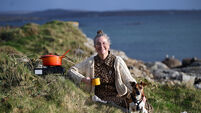Irish beef in a class of its own

Just why Irish beef tastes better than beef produced in many other countries will be explored in an upcoming episode of the RTÉ series 10 Things to Know About... which will look at the science behind the Irish beef sector’s international reputation.
Part of the reason beef produced here is prized abroad is because our cows, like those in Kobe in Japan, for example, are raised outdoors and on grass that has a high nutrient level, says presenter Dr Aoibhinn Ní Shúilleabháin.
She says Ireland is doing world-class research and it’s very important to showcase it so that people can see how relevant it is in everyday life.
Science also proves — or disproves — many of our common assumptions. When it comes to beef, though, the data shows that Irish beef really does stand apart.
Research to identify the genes and proteins associated with high-quality beef is ongoing while researchers continue to refine the DNA traits that make beef tender, juicy and give it flavour.
“To have some evidence to back up what we anecdotally think is important, because, internationally, Irish beef is becoming more and more popular, that is something that is very important for our economy and our export industry,” says Ní Shúilleabháin, an assistant professor at the UCD School of Mathematics and Statistics.
Dr Donagh Berry, research officer in genetics at Teagasc, outlines just how important beef is to our economy.
“The beef industry represents about a third of the gross agricultural output,” he says. “We are the largest exporter of beef in the Northern hemisphere [and] the fourth largest exporter in the world.”
The industry has always been concerned with managing the quality and yield of that meat, but now Teagasc, the Agriculture and Food Development Authority, is perfecting a genetics test that will predict the tenderness of beef.
There are lots of factors that affect the tenderness of a piece of steak, from leaving it on the pan too long to the way it is managed within the farm gate. If the animal is stressed at the time of slaughter, for instance, that will affect the meat’s quality and tenderness.
However, about 20% of the difference in tenderness in beef is due to genetics, Berry tells Feelgood. Over the past 16 years, Teagasc has been working to identify which of the 3 billion pieces of DNA are associated with tenderness. It’s an enormous task.
“We have undertaken preliminary genetic evaluations where you do statistical analysis of the data and you identify the animals you think are carrying the good genes,” he says.
In the long term, that will not only increase the tenderness of Irish beef, but it will lower costs as the quality will be inherent in the animal rather than dependant on feed or other environmental factors.
“We want to make sure that Irish beef is prized abroad and we want to continue that. Most of our animals, unlike other countries, are grazed outdoors. We also have an excellent traceability system. Our beef is very safe and it is produced in an environmentally friendly way.”
Teagasc is also working to reduce the environmental footprint of beef production. Now, the 0.8m cows in Ireland produce, on average, 0.8 calves each a year. The DNA programme at Teagasc hopes to get that closer to one calf a year.
“We are working to get the current herd to do a lot more, so that would reduce the environmental footprint of the sector per unit of beef,” he says.
However, should we be thinking about eating less meat or no meat at all to further help the environment, as former president Mary Robinson controversially suggested earlier this year?
Dr Berry says one of the things that is not always appreciated about cows is that they graze on pasture that is unsuitable for anything else.
“There is a huge role for these animals to provide food for the world. They tend to graze in areas that are unsuitable for anything else,” says Berry. “It’s different for pigs and chickens. They eat wheat and soya beans.”







